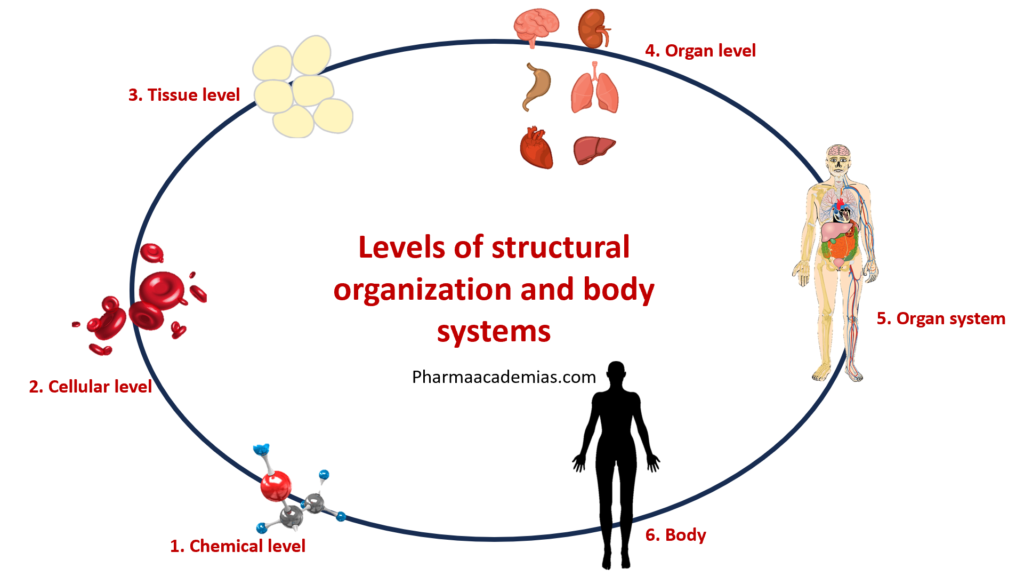Body systems: The human body’s structure and function are organized into various levels of structural organization, each building upon the previous level to create a complex, highly integrated system. Additionally, the body consists of several interconnected systems, each with its own specialized function.
Levels of Structural Organization Body systems
1. Chemical Level: This is the most basic level of organization and involves atoms and molecules. Atoms combine to form molecules, such as water, carbohydrates, lipids, proteins, and nucleic acids. Molecules are the building blocks of cells and are crucial for various biological processes.
2. Cellular Level: Cells are the smallest living units in the body and are considered the basic structural and functional units of life. Cells are highly specialized and perform specific functions. Examples include muscle cells, nerve cells, and blood cells.
3. Tissue Level: Tissues are formed when groups of similar cells work together to perform a common function. There are four primary types of tissues in the human body: epithelial (lining and covering), connective (support and protection), muscle (movement), and nervous (control and communication).

4. Organ Level: Organs are composed of multiple tissues working together to perform complex functions. Examples include the heart, lungs, liver, and brain. Each organ has a specific structure and function critical for overall health and homeostasis.
5. Organ System Level: Organ systems are groups of organs that work together to perform particular functions and maintain homeostasis. The human body has several organ systems. Examples of organ systems include the cardiovascular system (heart and blood vessels), respiratory system (lungs and airways), and nervous system (brain and nerves).
6. Organismal Level: At this level, all the organ systems work together to form a functioning human organism. The human organism is a highly complex, integrated system capable of maintaining life, responding to stimuli, and adapting to changing environments.
Body Systems
Integumentary system: The Integumentary System includes the skin, hair, nails, and glands, protecting the body from pathogens, regulating temperature, and preventing water loss. The skin, the largest organ, has three layers: epidermis (outer barrier), dermis (blood vessels, nerves, glands), and hypodermis (fat for insulation). It also aids in vitamin D synthesis and sensory perception.
Skeletal system: The Skeletal System consists of bones, cartilage, joints, and ligaments, providing support, protection, and movement. It maintains body structure, protects organs (e.g., skull protects the brain, ribs protect the heart and lungs), and facilitates movement with muscles. Bones also store minerals like calcium and produce blood cells in the bone marrow.
Muscular system: The Muscular System consists of skeletal, smooth, and cardiac muscles, enabling movement, posture, and heat production. Skeletal muscles control voluntary movements, smooth muscles regulate internal organs (e.g., digestion, blood flow), and cardiac muscle powers the heart. Muscles work with the skeletal system for coordinated movement.
Nervous system: The Nervous System includes the brain, spinal cord, and nerves, controlling body functions through electrical signals. It is divided into the central nervous system (CNS), which processes information, and the peripheral nervous system (PNS), which transmits signals between the CNS and the body. It regulates movement, sensations, reflexes, and higher functions like memory and thinking.
Endocrine system: The Endocrine System consists of glands such as the pituitary, thyroid, adrenal, pancreas, and gonads, which release hormones to regulate body functions. It controls metabolism, growth, reproduction, stress response, and homeostasis by maintaining balance in bodily processes.
Cardiovascular system: The Cardiovascular System includes the heart, blood, and blood vessels, transporting oxygen, nutrients, hormones, and waste throughout the body. The heart pumps blood, arteries carry oxygen-rich blood, veins return deoxygenated blood, and capillaries enable exchange between blood and tissues. It plays a key role in circulation, temperature regulation, and immune response.
Lymphatic and immune system: The Lymphatic and Immune System includes lymph nodes, lymphatic vessels, spleen, thymus, and white blood cells, helping in fluid balance, immunity, and defense against infections. The lymphatic system drains excess fluid and transports immune cells, while the immune system identifies and destroys pathogens to protect the body.
Respiratory system: The Respiratory System includes the lungs, trachea, bronchi, and diaphragm, facilitating oxygen intake and carbon dioxide removal. Air enters through the nose or mouth, passes through the trachea and bronchi, and reaches the lungs, where gas exchange occurs in the alveoli. The diaphragm aids breathing by expanding and contracting the lungs.
Digestive system: The Digestive System includes the mouth, esophagus, stomach, intestines, liver, and pancreas, breaking down food for nutrient absorption and waste elimination. Digestion begins in the mouth, continues in the stomach with enzymes and acids, and nutrients are absorbed in the small intestine. The large intestine absorbs water, and waste is excreted. The liver processes nutrients, and the pancreas produces digestive enzymes.
Urinary system: The Urinary System includes the kidneys, ureters, bladder, and urethra, responsible for waste removal and fluid balance. The kidneys filter blood, removing toxins and excess water to form urine, which travels through the ureters to the bladder for storage and is excreted through the urethra. It also helps regulate electrolytes, blood pressure, and pH balance.
Reproductive system: The Reproductive System enables reproduction and hormone regulation. In males, it includes the testes, prostate, and sperm ducts, producing sperm and testosterone. In females, it consists of the ovaries, uterus, and fallopian tubes, responsible for egg production, fertilization, and pregnancy. Hormones like estrogen, progesterone, and testosterone regulate reproductive functions.
These body systems work collaboratively to maintain the body’s internal environment, respond to external stimuli, and ensure survival and overall health. Dysfunction in any of these systems can lead to various health issues and diseases, highlighting the importance of understanding the levels of structural organization and the interdependence of body systems in maintaining homeostasis.

